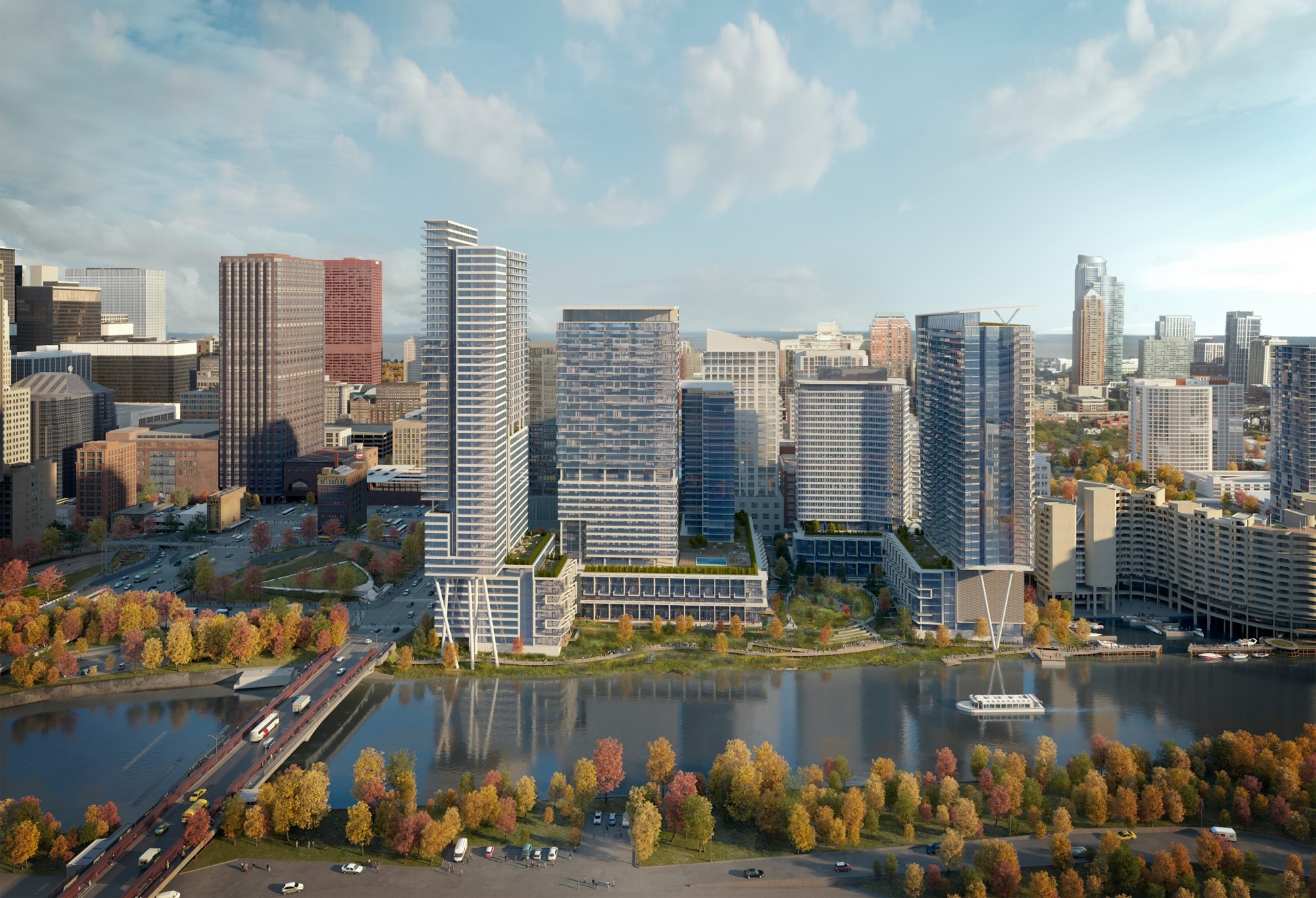
In Chicago, an array of river-centric ecosystems is replacing bleak concrete constructions and train tracks. And a wetland aims to return the South Bank of the Chicago River to the natural environment it once was—an untamed habitat for native flora, fauna, and migratory birds.
In September 2016, Perkins+Will, with landscape architecture firm Hoerr Schaudt, were joined by development partners CMK Companies and Lendlease to celebrate the groundbreaking of the South Loop’s 3600-unit Riverline project—“one of the most anticipated and arguably important developments to come to Chicago’s near south side in recent years.”
The impact of Riverline from an architectural and housing perspective has been spoken about in depth, but what will make the development even more impactful is its ecological story.
With the development spread across eight river-facing buildings, Riverline will be constructed in phases, with the first phase featuring the construction of Building D (known as Ancora), Building G (known as Current) and a series of townhouses collectively referred to as Building H (or Watershed). What’s most unique about this first phase is that it will also contain 3.6 acres [1.4 hectares] of green space, carefully crafted by landscape architect Hoerr Schaudt.

In a departure from decades of riverfront improvement in Chicago, Riverline is oriented around significant public and private spaces facing the river. It was intentional to have the full length of Riverline’s west boundary face the Chicago River edge in order to integrate a natural river edge into the design of Riverline’s riverwalk, totaling .56 miles.
Creating habitat
Riverline’s 14-acre [5.7 hectares] site once existed as a pivotal rail center for Chicago from 1890 to 1969, then sat fallow for several decades until the Riverline design process began in 2014, with the development team encountering a site covered with non-native grass species and a river edge dominated with successional species, typical of highly disturbed sites.
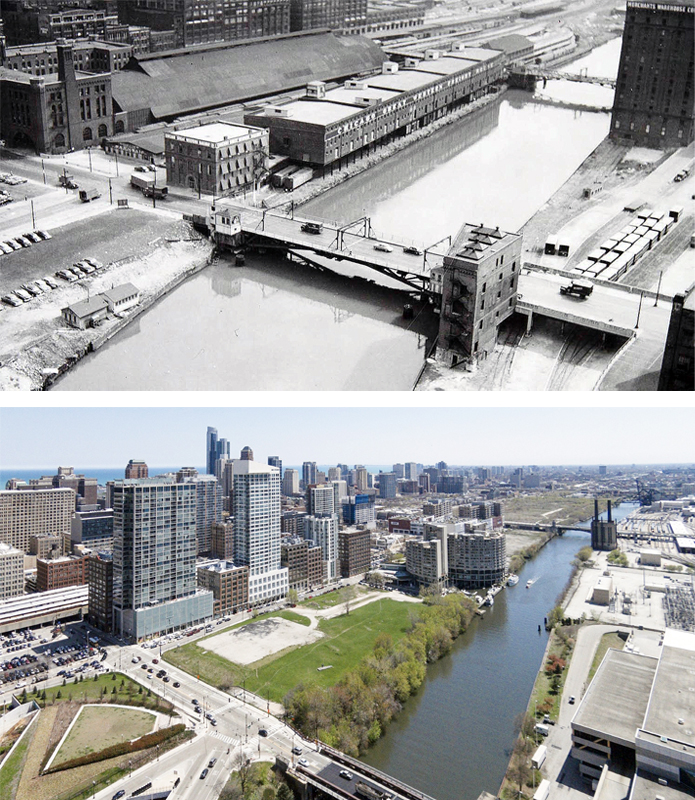
industrial, “working” Chicago River. Bottom: Existing conditions
in 2014, with Bertrand Goldberg’s River City dividing the North
and Side portions of Riverline.
To abet the habitat goals that include a variety of upland savannahs, prairies, and wet prairies, the site includes several corridors that feature stream and wetland habitats, and also reintroduce several aquatic species.
Specifically, reclaimed logs are included in the installation plan to provide habitat for crayfish, mollusks, painted turtles, frogs, toads, and salamanders. Also, specially selected trees and aquatic plantings along the river edge will provide further habitat and cover for the introduced aquatic species. This allows residents and visitors to get up close to wetland habitat and observe the animal species that call this place home.
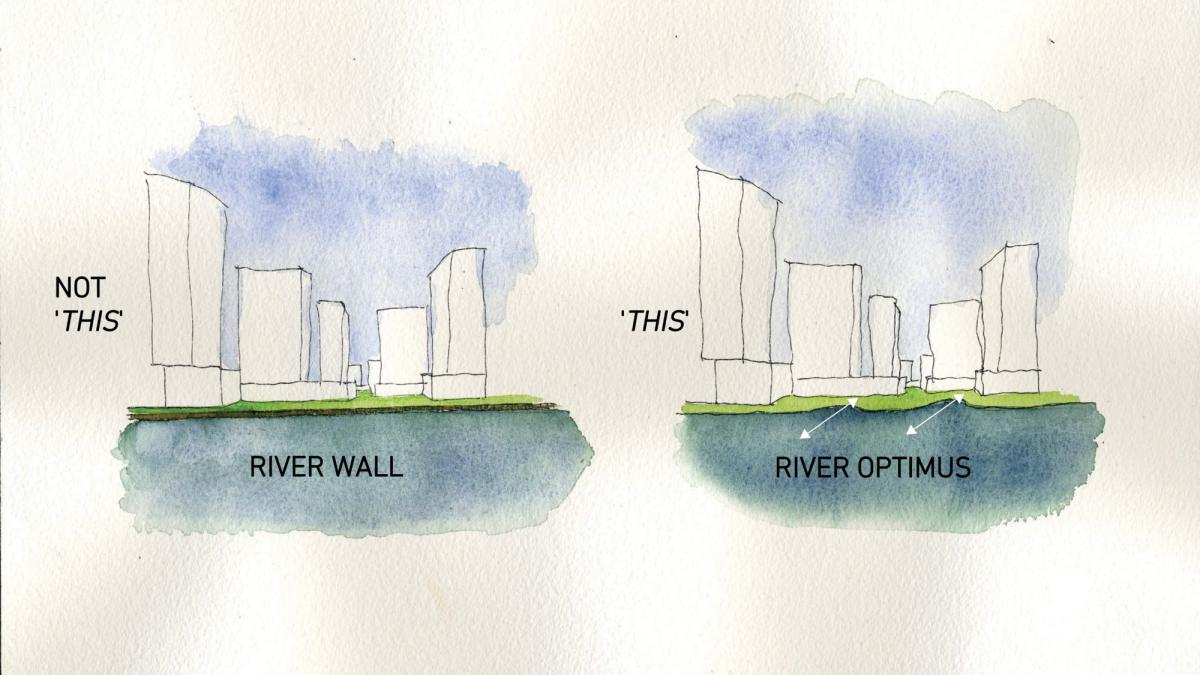
To naturalize this urban edge, the design features several different plant communities native to the region including wetland, prairie, and savannah. This reestablishment of the local ecosystem within the site serves an important role in absorbing stormwater, creating habitat and food for wildlife, and forming enjoyable public spaces.
Managing stormwater
To diversify the flora and fauna on site while responding to complex hydrological processes, Riverline hopes to manage volume for a 100-year storm event and simultaneously create a biologically healthy hydrograph. To accomplish this, water is harvested from building roof tops and the open space, which is then routed into a recirculating wetland system. This re-use and conservation effort aids in cleaning the green roof, while acting as a biofilter for the wetland and native landscape. Hoerr Schaudt brought in Applied Ecological Services to develop plant lists for each of the plant communities in this system, and to create the drawings and specifications to allow the restoration project to be installed successfully.
 A site the size of Riverline—approximately 26 acres—can help address a problem present in Chicago and many cities: Combined Sewer Overflow (or CSO). This is a topic, or rather ecological event, Shannon Gedey and Tom Seiple touched on earlier this May, describing how Chicago managing its storm and waste water in the same pipe, called a combined sewer. This works well in average weather patterns when the rainwater helps carry sewer waste to the treatment plant. However, in a large rain event, say one-inch of rainfall, the treatment plant’s capacity is exceeded and both the rain water and the sewer waste are released into the Chicago River. This occurrence is called a Combined Sewer Overflow, or CSO.
A site the size of Riverline—approximately 26 acres—can help address a problem present in Chicago and many cities: Combined Sewer Overflow (or CSO). This is a topic, or rather ecological event, Shannon Gedey and Tom Seiple touched on earlier this May, describing how Chicago managing its storm and waste water in the same pipe, called a combined sewer. This works well in average weather patterns when the rainwater helps carry sewer waste to the treatment plant. However, in a large rain event, say one-inch of rainfall, the treatment plant’s capacity is exceeded and both the rain water and the sewer waste are released into the Chicago River. This occurrence is called a Combined Sewer Overflow, or CSO.
If a site of Riverline’s size keeps all of its rainwater on-site instead of sending it to a storm sewer, then that volume of water does not need to be treated by the treatment plant (reducing electricity usage); and in a large rainfall, the treatment plant will have greater capacity to treat combined sewer water, reducing the likelihood of an overflow.
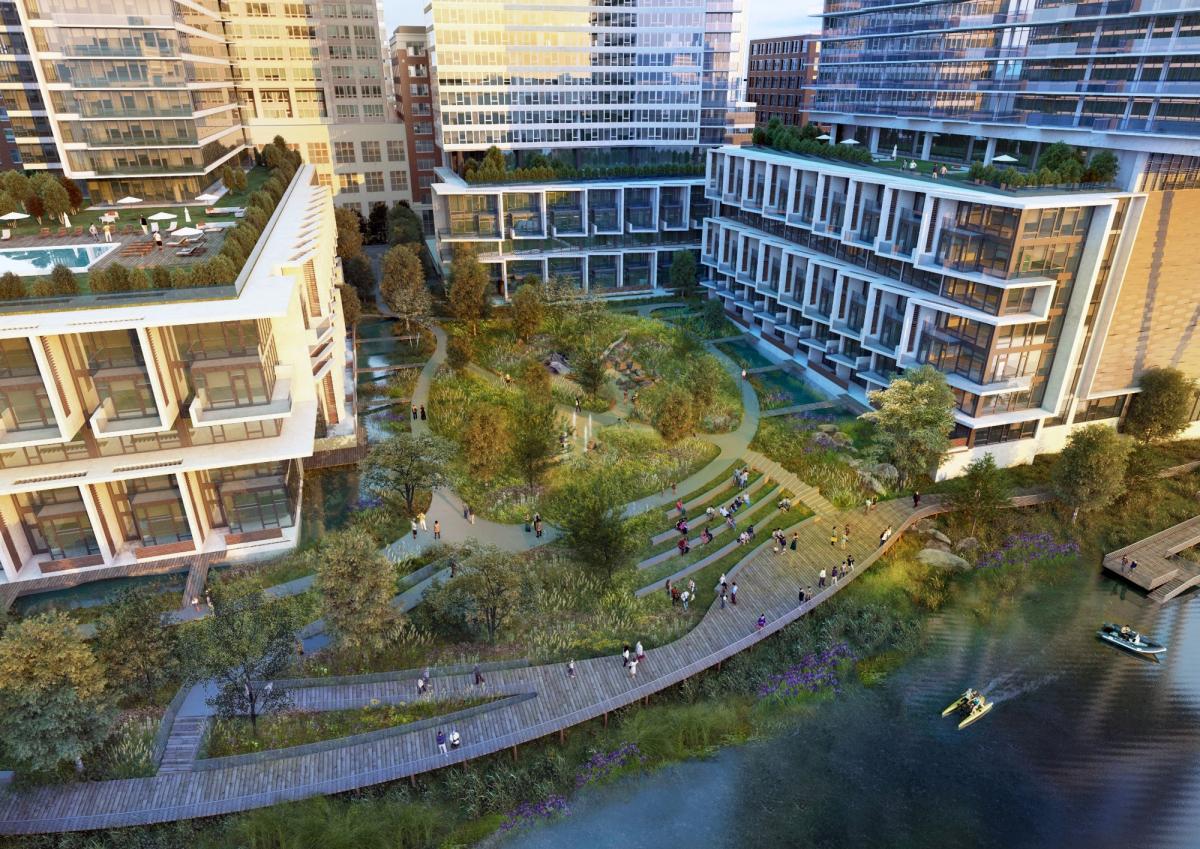
The challenge is how Riverline keeps its stormwater on-site while also considering the goals of the whole team—the developer’s desire to create profitable residential development, the architect’s desire to create designs that represent the broader goals of society, the landscape architect’s goal as steward of the environment—meet goals of client, and create a successful social space for residents and the city of Chicago.
Keeping stormwater on-site in tanks is expensive and takes up space that could be used for parking. Hoerr Schaudt proposed to make this extra water an amenity, such as a lily pond, a place where residents could rest their feet or cast a fishing pole in to the water. Hoerr Schaudt designed a series of stepped wetlands that line the development and wrap a naturalistic park at the development’s core that store rainwater from the roof and paved surfaces. The stored water is transpired through the plant material and absorbed into the ground. The design participates in the environmental context that is the Chicago River and makes the river cleaner by not contributing to CSO events.
Forming physical water connections
 Water plays an immense role in the design of Riverline. It’s the program-
Water plays an immense role in the design of Riverline. It’s the program-
matic and operational anchor to engage people with the river, and emphasizes its value as one of Chicago’s greatest amenities. From the start, the development team heavily emphasized bringing the natural environment into the local resident’s daily lives by creating landscapes that attract birds, amphibians, and insects to make the Riverline experience more meaningful and memorable. Specific interactions with the water include the wetland area overflowing when a high-rain event occurs, with the water cascading onto a stepped stone outfall. This clean water creates an impromptu waterfall effect, allowing the water to infiltrate into the surrounding landscape, reducing the burden on Chicago’s stormwater infrastructure as it enters the river.
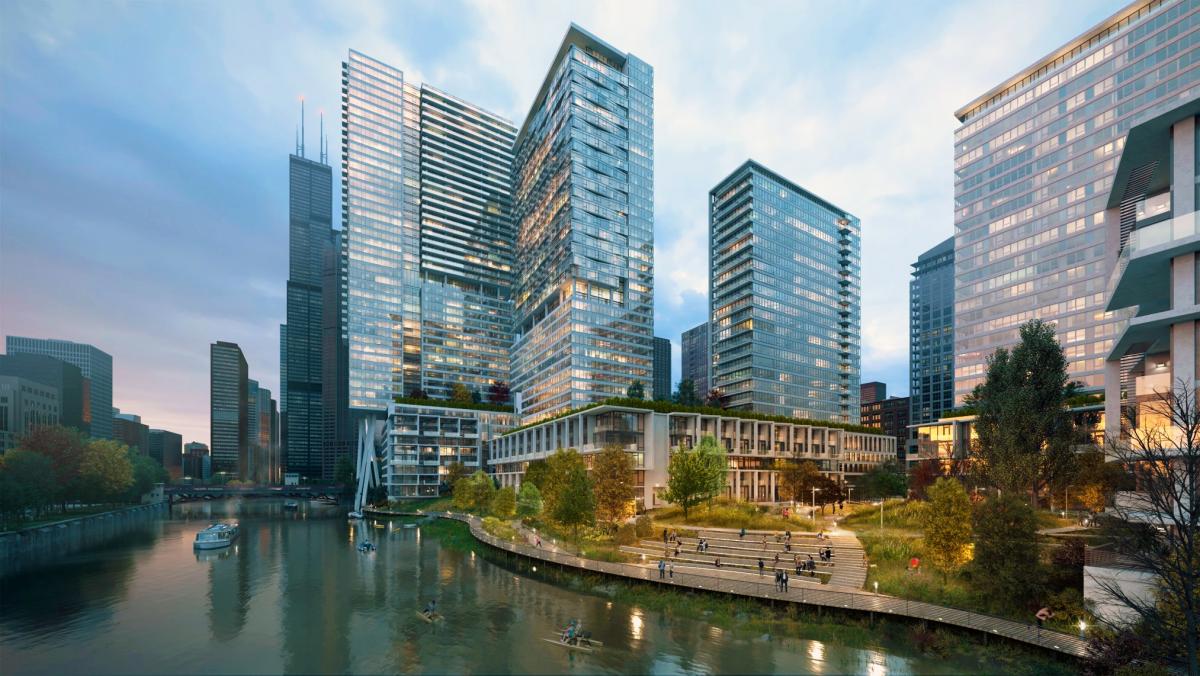
With the development’s overall mission being “Discover your urban nature,” the Riverline experience extends into opportunities completely unique for an urban environment with Riverline’s denizens and the public being able to interact with the river edge for education, fishing, kayaking—and they can take advantage of a canoe launch and a water taxi stop, as well.
The Riverline’s three ecological tenets of forming physical connections with water, managing stormwater, and creating habitat are incorporated into the overall vision and plans for the site, but they are also highly reflected in the long-term management of the development. Establishing a diverse, healthy habitat was essential to Riverline, its specific location within the city, and along the river. It was only possible because the development and design teams wanted Riverline to embrace its context, placing equal importance on the resident experience as it did the ecological framework. 
This article was reprinted in its entirety through the courtesy of Perkins+Will. Read the original article here.

